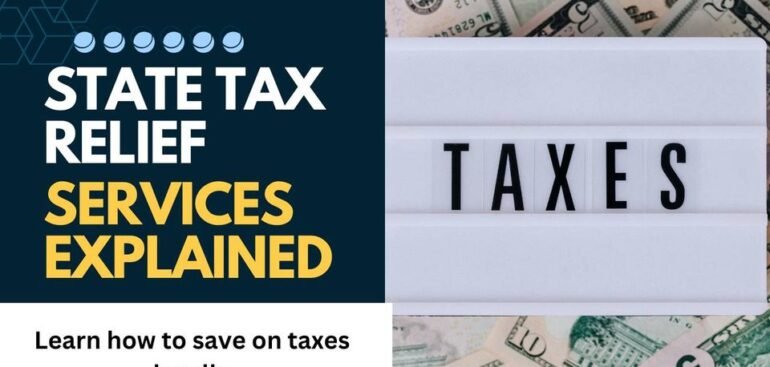When managing your finances, understanding state tax relief services can be a game-changer. These services are designed to help individuals and businesses reduce their tax burdens and navigate complex state tax regulations. In this comprehensive guide, we’ll explore how tax relief services can save you thousands of dollars and why you should consider starting now.
What Are State Tax Relief Services?
State tax relief services encompass a range of programs and strategies aimed at reducing the amount of state tax you owe. These services can include tax deductions, credits, exemptions, and other forms of relief that can significantly lower your tax liability. By utilizing state tax relief services, you can keep more of your hard-earned money.
Benefits of State Tax Relief Services
Understanding the benefits of state tax relief services is crucial. These services can:
- Reduce your overall tax burden
- Provide financial stability
- Help you stay compliant with state tax laws
- Offer peace of mind by resolving tax issues
Types of State Tax Relief Services
There are several types of state tax relief services available, each designed to address different tax situations. Some common types include:
- Tax deductions
- Tax credits
- Tax exemptions
- Payment plans
- Penalty Abatement
How to Qualify for State Tax Relief Services
Qualifying for state tax relief services often depends on your specific financial situation and the type of relief you’re seeking. Generally, you may need to provide documentation of your income, expenses, and any financial hardships. Working with a professional tax service can help you determine your eligibility and navigate the application process.
The Role of Professional Tax Services
Professional tax services, like those offered by ExactLedgers, play a crucial role in helping you maximize your state tax relief. Our team of experts understands the complexities and ever-changing landscape of tax laws and regulations. We provide tailored tax solutions for both individuals and businesses, ensuring accurate, compliant, and strategic tax planning.
How ExactLedgers Can Help
At ExactLedgers, we offer comprehensive individual and corporate taxation services designed to minimize your liabilities and maximize your returns. Our services include:
- Tax preparation and planning
- Tax compliance and reporting
- Strategic tax advice
- Resolution of tax disputes
- Audit support
Our goal is to provide you with the best possible tax solutions to meet your unique needs.
Real-Life Examples of State Tax Relief Services
To better understand the impact of tax relief services, let’s look at a few real-life examples:
- Homeowner Tax Credits: Many states offer tax credits to homeowners for improvements that increase energy efficiency.
- Small Business Relief: States often provide tax incentives to small businesses for creating jobs or investing in local communities.
- Disaster Relief: In the event of natural disasters, states may offer tax relief to affected individuals and businesses to help them recover.
Steps to Take Advantage of Tax Relief Services
To start benefiting from state tax relief services, follow these steps:
- Research: Learn about the specific tax relief programs available in your state.
- Consult a Professional: Work with a tax professional, like ExactLedgers, to understand your eligibility and maximize your benefits.
- Apply: Submit the necessary documentation and applications for the tax relief programs you’re eligible for.
- Stay Informed: Keep up-to-date with any changes in state tax laws and regulations that may affect your tax situation.
Why You Shouldn’t Wait
The sooner you take advantage of tax relief services, the sooner you can start saving money. Delaying can result in missed opportunities for tax savings and increased financial strain. By acting now, you can ensure that you’re taking full advantage of all available tax relief options.
Conclusion
In conclusion, tax relief services can provide significant financial benefits, helping you save thousands of dollars. By understanding the different types of relief available and working with a professional tax service like ExactLedgers, you can navigate the complexities of state tax laws and maximize your savings. Start now and take control of your financial future.
FAQs About State Tax Relief Services
Q: What are state tax relief services? A: tax relief services are programs and strategies that help individuals and businesses reduce their state tax liabilities through deductions, credits, exemptions, and other relief measures.
Q: Who qualifies for state tax relief services? A: Eligibility varies based on the specific relief program and your financial situation. Generally, you may need to provide documentation of income, expenses, and any financial hardships.
Q: How can I apply for state tax relief services? A: To apply, research available programs, gather necessary documentation, and submit applications to the appropriate state tax authorities. Consulting a tax professional can streamline the process.
Q: How much can I save with state tax relief services? A: Savings vary depending on the type of relief and your tax situation. Some individuals and businesses save thousands of dollars by utilizing these services.
Q: Can I use multiple state tax relief services? A: Yes, you can often combine different types of tax relief services to maximize your savings. A tax professional can help you identify and apply for all applicable relief options.


